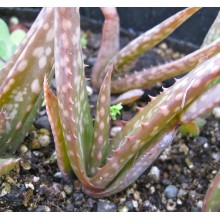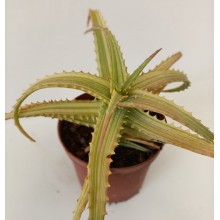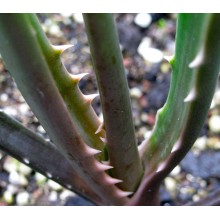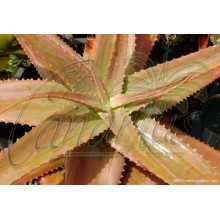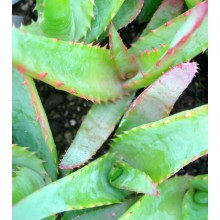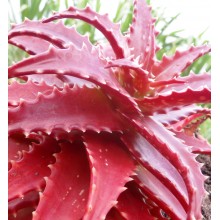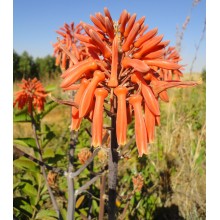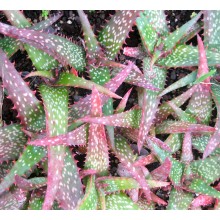Aloe, Gasteria und Haworthia Es gibt 70 Artikel.

Aloe, Gasteria und Haworthia sind drei verwandte Gattungen, unter die hunderte sukkulente Pflanzen. Sie wachsen alle einfach im Blumentopf. Manche sind an das geringe Licht drinnen angepasst und können als Hauspflanzen verwendet werden.
- Aloe ist eine Gattung, die etwa 400 Arten umfasst, beheimatet in Afrika, auf der arabischen Halbinsel und auf Madagaskar. Kleine oder Zwerg-Aloen werden besonders in kälteren Klimas immer beliebter da sie in den kalten Monaten nach drinnen genommen werden können.
- Gasteria umfasst 80 Arten, die im Süden Afrikas beheimatet und bekannt für ihre spektakulären Blätter, die glänzend, meliert und reliefiert sind. Sie blühen im Frühling und Sommer mit langen stachelförmigen kleinen orangen Blüten. Manche Arten sind so unterschiedlich, dass wir besondere Klone von bestimmten Orten anbieten.
- Haworthia ist eine Gattung die aus dem Süden Afrikas stammt mit etwa 70 Arten und einigen lokalen Unterarten, Variationen und Formen. Die Blätter sind oftmals gebändert, gepunktet, gesprenkelt oder semi-transparent und zeigen weit gefächerte Variationen.
-
Aloe abyssicola
Aloe abyssicola
We offer a 8-14 cm rooted plant. This is a distinctive mid-sized aloe that grows on cliffs, in Yemen. Rosettes grow asymmetrically on a side, with beautiful, wide dull mottled leaves with widely spaced spines.
29,40 € -
Aloe arborescens 'Variegata'
Aloe arborescens 'Variegata'
This variegated clone of Aloe arborescens is just as easy to grow and to make it bloom as the true species, which is a popular ornamental shrub from South Africa. It just grows a bit slower and smaller. Leaves are jade-green, with yellow stripes.
34,00 € -
Aloe barberae - Large
Aloe barberae - Large
6 years - 60-70 cm tall. The largest of all aloes. This South African aloe tree grows as huge as a Dracaena draco and can attain 6-16 m in height. It takes light frosts and it is a must for Mediterranean gardens.
148,00 € -
Aloe brevifolia
Aloe brevifolia
Smaller leaved form of a low growing, clumping aloe. This dwarf form has a very manageable size and it is great for pots. This species from South Africa can stand some frost.
13,80 € -
Aloe bulbilifera var. paulianae
Aloe bulbilifera var. paulianae
Aloe bulbilifera is different because it is viviparous: new pups sprout from the inflorescence and grow larger when the red flowers are gone. This is the variety called paulianae. It has an elegant rosette turning copper-pinkish in full sun.
15,20 € -
Aloe bulbilifera var. paulianae - Large
Aloe bulbilifera var. paulianae - Large
Rosette 30 - 50 cm diam. Aloe bulbilifera is different because it is viviparous: pups sprout from the inflorescence and grow larger when the red flowers are gone. This is the variety called paulianae.
22,70 € -
Aloe comosa
Aloe comosa
We offer a 13-18 cm diameter plant. This large stemmed aloe grows to a height of 1-3 m, unbranched. The bold rosette has a rusty-copper colour. It blooms with tall multiple spikes of red and yellow flowers. It is native to a small area close to Clanwilliams, e Western Cape.
15,20 € -
Aloe dorotheae - Large
Aloe dorotheae - Large
This is one of the most colourful low-growing aloes, a delightful garden plant with glossy cherry-red leaves when exposed to full sun. It is becoming increasingly popular in Tenerife, while it is critically endangered in the wild.
38,80 € -
Aloe elegans Ethiopia
Aloe elegans Ethiopia
Mid-sized stemless Aloe, widespread and locally abundant in northern Ethiopia and in Eritrea. It grows solitary or forming small groups. It grows on rocky slopes, mostly on sandstone or limestone, in areas with evergreen bushland or wooded grassland. This batch is from Ethiopian populations.
16,50 € -
Aloe erinacea
Aloe erinacea
Collector's aloe from harsh dry mountains in Namibia. It is a small gem with green-gray leaves full of white spines often tipped in red. It does not like to be overwatered!
12,50 € -
Aloe greatheadii var. davyana
Aloe greatheadii var. davyana
Variable South African aloe with colourful leaves, of different greens, oranges, browns and even greys. They typically show abundant "H marks".
22,50 € -
Aloe haworthioides
Aloe haworthioides
Miniature aloe from central Madagascar. It slowly forms a clump of diminute rosettes with "hairs". It is slow but forgiving in cultivation and can grow by a bright window, much like haworthias. Avoid frost, it can barely stand it!
12,20 € -
Aloe juvenna
Aloe juvenna
Cont. 8 cm. It is native to South Africa and its grows vertically and grouped.Its leaves from green spiral rosettes whith specks and small spines.
10,20 € -
Aloe labworana
Aloe labworana
Stemless aloe with yellow flowers, native to rocky outcrops in the mountains of northern Uganda and southern South Sudan between 1300 and 1500 m.
23,20 € -
Aloe lavranosii
Aloe lavranosii
Aloe lavranosii is a native of Yemen on the Arabian Peninsula. It is one of the few species of Aloe with "hairy" flowers. Plants grow usually solitary with blueish leaves.
14,20 € -
Aloe lineata
Aloe lineata
South African species with blue-green leaves marked with longitudinal red lines (hence "lineata"). It branch from the base and produces erect stems, so it eventually becomes a dome-shaped shrub, 1-2 m tall.
13,40 € -
Aloe maculata
Aloe maculata
Slowly clumping rosette,with elegant red inflorescences held on tall stalks. The dark green leaves have the typical white H spots.It is a widespread South African aloe tolerant of different conditions.
10,80 € -
Aloe perfoliata
Aloe perfoliata
Cont. 8 cm. It is native to South Africa and its characterized by prostrate, long and branching stems that isn't stend of growing upright but they tend to sprawl along the ground and over rocks.
11,70 € -
Aloe plicatilis (Kumara plicatilis)
Aloe plicatilis (Kumara plicatilis)
Thick 15-20 cm 1-y old rooted plant - It is a spectacular species, relative of the genus Aloe with leaves arranged as fans. Kumara plicatilis grows as a shrub or small tree and thrives outdoors in the coastal Mediterranean. It blooms in winter and its flowers are much larger than most aloes !
45,00 €
Im Moment gibt es nur wenige Produkte in dieser Kategorie Aloe, Gasteria und Haworthia

















